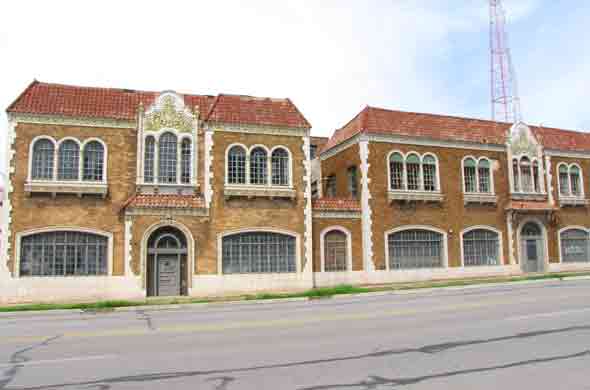 (The Midtown KC Post is profiling the buildings on the Historic Kansas City Foundation’s Most Endangered List for 2013. More about our series of stories.)
(The Midtown KC Post is profiling the buildings on the Historic Kansas City Foundation’s Most Endangered List for 2013. More about our series of stories.)
Like the past parked on a streamlined lot of the present, an ornate building with broken windows sits just behind the Costco in Midtown.
It is the Luzier Cosmetics Building at 3225 E. Gillham Plaza, designed in 1928 by prolific and belatedly famous Kansas City architect Nelle Peters.
While the long vacant building is not on the Historic Kansas City Foundation’s recent top 10 list of endangered buildings, it is on their watch list.
Peters designed buildings throughout Midtown and the city but when she died in 1974, “virtually no one acknowledged the significance of her accomplishments,” the Kansas City Public Library reported in an article called “Forgotten but not gone.”
Many of the more than 1,000 buildings she designed are still standing.
One is the Ambassador Hotel at 3560 Broadway – the largest apartment-hotel in the city when finished in 1924. Renovation is scheduled to begin on it later this year, preserving one of her larger works.
She also designed the Valentine apartment-hotel, just to the south on Broadway, but was known mainly for smaller apartment buildings that featuring terra cotta ornamentation and courtyards.
In the 1980s, the city created the Nelle Peters historic district of many of her apartments on the corner of Southwest Trafficway and 37th Street.
According to the library report:
Born in 1884 as Nelle Nichols, she grew up on the North Dakota prairie until her family moved to Iowa, where she studied math and art in college.
A Sioux City architectural firm transferred her to Kansas City in 1909, but she soon worked on her own.
In 1909, she married William H. Peters, a Kansas City Terminal Railway designer and took his last name. They divorced in 1923.
Her career took off in 1913 when she did work for real estate developer and builder Charles E. Phillips, who hired her for dozens of projects.
Among those were seven apartment buildings just west of the Country Club Plaza known as the literary block because they were each named for famous authors.
While much of her work was apartments and hotels, she also designed private homes and business buildings like that for Luzier cosmetics.
“Her careful attention to detail brought her some national recognition within the architectural profession,” the library reported. “She was capable of minimizing the total area taken up by her designs while still giving them an open feeling and functional spaces inside….”
Starting in 1930, the depression and then World War II took a toll on her career. She suffered a period of illness and had to work as a seamstress to survive.
She retired in 1967 and died in obscurity at a nursing home seven years later, at age 90.



Who’s talking